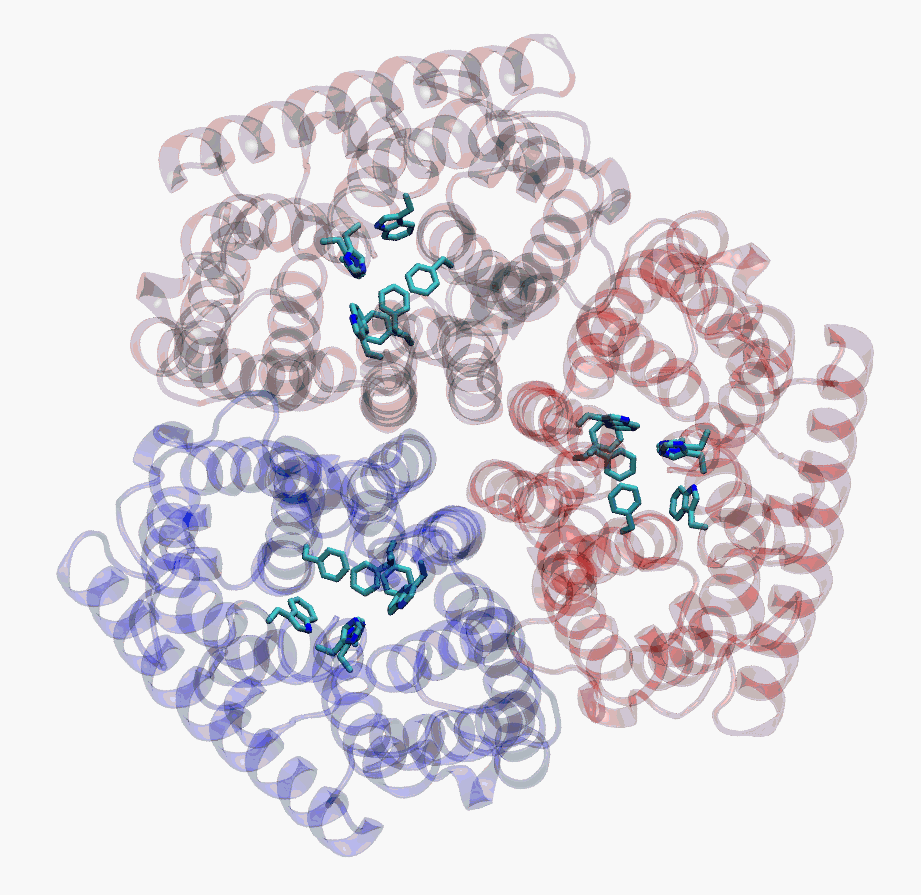Welcome to the webpage of the laboratory of Guillaume Lamoureux. Research in the lab is focused on applying theoretical and computational methods to fundamental problems in chemistry and biology.
We are interested in enzyme catalysis, membrane transport, and molecular recognition. Understanding these processes — and how they can be inhibited or enhanced — is at the core of many pressing issues in biology and medicine.
Our research is at the confluence of physical chemistry, theoretical chemistry, and theoretical biophysics. It relies on a solid understanding of molecular interactions and on a wide array of methods in modeling and in statistical mechanics. It makes extensive use of computers. The laboratory has access to computational resources from the Centre for Research in Molecular Modeling (CERMM) and from Calcul Québec and Compute Canada.
See this recent story on our research.
Here are some active research projects in the laboratory:
Protein-protein interactions
Proteins often acquire their biological activity by associating with one another and forming larger functional units. Finding out which two proteins are likely to interact is a difficult problem, since humans have around 20,000 protein-coding genes — creating a very large number of pairs of potential interaction partners. Moreover, this large network of interactions can be affected by mutations such as those occurring in cancer.
We are developing fast computer algorithms to predict residue-residue contacts and protein-protein interactions and to infer which mutations are likely to perturb these interactions (and affect biological function). We are taking advantage of a number of recent developments in a field of computer science called deep learning. Deep learning technologies are commonly used for automatic translation and for voice or image recognition. Treating the interaction of two proteins as a form of recognition — molecular recognition —, we are developing deep learning algorithms trained to predict the likelihood of any two proteins interacting.
Metalloproteins
This theme of research is related to computational enzymology, which is the study of enzymes and enzymatic reactions using molecular modeling and computer simulations. Computational enzymology aims primarily at describing the structure and relative energy of the short-lived states along an enzymatic reaction and at connecting them into an atomically-detailed kinetic picture. Because these short-lived states are usually not accessible through experimental techniques, it can provide new levels of insight to otherwise well-characterized reactions, and new interpretations to poorly-understood reactions.
We are developing methods for computational enzymology and applying them to enzymes containing metal atoms at their active sites (zinc, magnesium, manganese, etc.). Although about half of all known proteins contain at least one metal atom, no method is currently available to efficiently and reliably simulate chemical reactions in metalloenzymes. We are focusing on zinc hydrolases, which are involved in numerous biological functions such as blood pressure regulation, digestion, intra-ocular pressure regulation, and bacterial resistance to antibiotics.
Our research objectives are the following:
- Develop methods for computational enzymology that are accurate enough to analyze the energetics of steps along enzymatic reactions, yet efficient enough to observe the catalytic effects of large-scale protein motion occurring on the nanosecond time-scale.
- Uncover new structure-function relationships in enzymes. In particular, we want to get a better understanding of the effects of metal and ligand substitution in metalloenzymes, of the effects of ligand binding on the motion of enzymes, and of the catalytic role of residues separated from the reaction site.
- Enable new computational strategies for enzyme inhibitor design.
Ammonium transporters

Although lipid membranes are relatively permeable to ammonia, bacteria, yeast, and plants under too low ammonium concentrations express transmembrane proteins from the Amt/MEP family that have a high affinity for ammonium and facilitate its transport across the membrane. In mammals, a similar function is performed by the analogous Rhesus (Rh) proteins, present in red blood cells, liver cells, and kidney cells.
The first x-ray structures of proteins from the Amt/MEP/Rh family have been obtained only very recently, for the bacterial ammonium channel AmtB and for the archaeal channel Amt-1. Although these structures provide a lot of insight into the general mechanism of Amt proteins, no conclusion has been reached on the nature of the permeant species. Depending on the specific Amt protein (in bacteria or in plants), experiments suggest a net transport of either NH3 or NH4+.
The nature of the permeant species is even more uncertain in Rh proteins. Some experiments indicate that they facilitate ammonia transport across membranes, but some others suggest that they are in fact carbon dioxide (CO2) channels. Phylogenetic studies of the Rh family imply that Rh proteins may indeed have evolved a function distinct from that of the Amt/MEP family. Given how chemically different NH3 and CO2 are, the notion that homologs of ammonia transporters can function as carbon dioxide channels is intriguing.
We are interested in answering the following questions:
- What chemical species are allowed in and out of the pore of AmtB?
- What are the important interactions along the permation pathway?
- Is AmtB an ammonia channel or an ammonium transporter?
- Are Rh proteins carbon dioxide channels as it was suggested?



